ICU患者血糖的监测与管理
ICU患者的血糖监测与管理
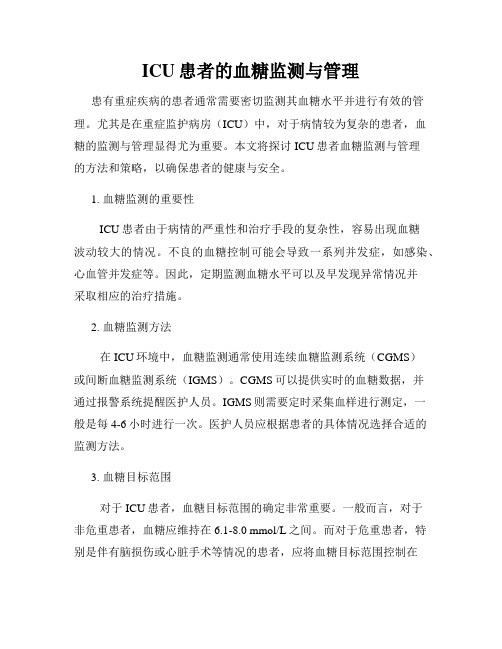
ICU患者的血糖监测与管理患有重症疾病的患者通常需要密切监测其血糖水平并进行有效的管理。
尤其是在重症监护病房(ICU)中,对于病情较为复杂的患者,血糖的监测与管理显得尤为重要。
本文将探讨ICU患者血糖监测与管理的方法和策略,以确保患者的健康与安全。
1. 血糖监测的重要性ICU患者由于病情的严重性和治疗手段的复杂性,容易出现血糖波动较大的情况。
不良的血糖控制可能会导致一系列并发症,如感染、心血管并发症等。
因此,定期监测血糖水平可以及早发现异常情况并采取相应的治疗措施。
2. 血糖监测方法在ICU环境中,血糖监测通常使用连续血糖监测系统(CGMS)或间断血糖监测系统(IGMS)。
CGMS可以提供实时的血糖数据,并通过报警系统提醒医护人员。
IGMS则需要定时采集血样进行测定,一般是每4-6小时进行一次。
医护人员应根据患者的具体情况选择合适的监测方法。
3. 血糖目标范围对于ICU患者,血糖目标范围的确定非常重要。
一般而言,对于非危重患者,血糖应维持在6.1-8.0 mmol/L之间。
而对于危重患者,特别是伴有脑损伤或心脏手术等情况的患者,应将血糖目标范围控制在8.1-10.0 mmol/L。
但是,这些目标范围也需要根据患者的具体情况进行调整。
4. 血糖管理策略血糖管理策略应根据患者的特点和治疗需求来制定。
一般而言,对于ICU患者,采用靶控制血糖策略比固定剂量血糖管理更为有效。
靶控制血糖策略将血糖控制在目标范围内,可以减少低血糖和高血糖的发生。
此外,还可以通过静脉输液进行胰岛素治疗,以保持血糖的稳定。
5. 多学科合作血糖监测与管理需要多学科的合作,包括医生、护士、营养师和糖尿病专科医生等。
医生应根据患者的具体情况制定个性化的治疗方案,护士负责监测血糖和执行治疗措施,营养师提供合理的饮食建议,糖尿病专科医生提供专业的指导和建议。
只有多学科的合作才能确保患者的血糖控制达到最佳效果。
总结:ICU患者的血糖监测与管理对于患者的康复和疾病预后至关重要。
血糖监测ICU
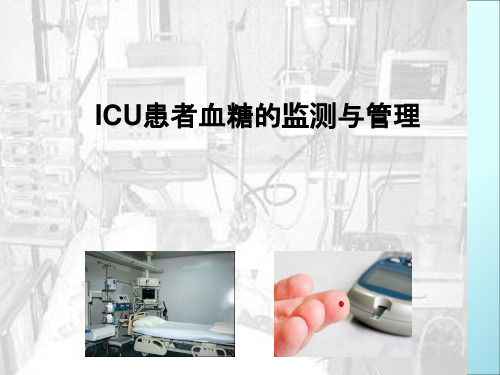
其他 糖尿病、肥胖症、某些药物, 包括糖皮质激素、 拟交感神经药物和免疫抑制剂等也可引起高血糖。
• 胰腺储备 • 胰岛素抵抗
患者体质
应激性 高血糖
疾病因素
• 儿茶酚胺类 • 下丘脑-垂体-肾上腺轴激活作用 • 炎性细胞因子 • 脂毒性
治疗因素
1.We recommend that, following initial stabilization, patients with severe sepsis and hyperglycemia who are admitted to the ICU receive IV insulin therapy to reduce blood glucose levels (Grade 1B)
We suggest use of a validated protocol for insulin dose adjustments and targeting glucose levels to the < 150 mg/dl range (8.3mmol/L) (Grade 2C)
我们建议使用有效的方案来调整胰岛素剂量,目标 血糖水平为 < 150 mg/dl (8.3mmol/L) (Grade 2C)
可能升高因素:
- 糖原异生↑, 糖原分解↑ - 应激激素↑(儿茶酚胺类/糖皮质激素/生长激素) - 促炎症介质细胞因子/趋化因子↑ - 转录因子↑ - 使用外源性糖皮质激素治疗 - 使用外源性葡萄糖静脉注射,肠内/胃肠外IIT治疗,进行严格血糖控制
低血糖
损害神经系统
✓ 在外科加强监护病房的危重病人中,降血 糖维持在110mg/dl或以下的强化胰岛素治疗 可降低并发症发生率和死亡率。
ICU患者的血糖监测与糖病管理
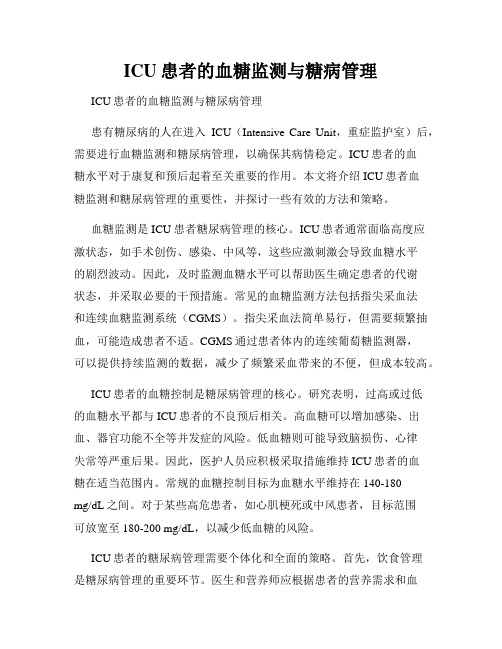
ICU患者的血糖监测与糖病管理ICU患者的血糖监测与糖尿病管理患有糖尿病的人在进入ICU(Intensive Care Unit,重症监护室)后,需要进行血糖监测和糖尿病管理,以确保其病情稳定。
ICU患者的血糖水平对于康复和预后起着至关重要的作用。
本文将介绍ICU患者血糖监测和糖尿病管理的重要性,并探讨一些有效的方法和策略。
血糖监测是ICU患者糖尿病管理的核心。
ICU患者通常面临高度应激状态,如手术创伤、感染、中风等,这些应激刺激会导致血糖水平的剧烈波动。
因此,及时监测血糖水平可以帮助医生确定患者的代谢状态,并采取必要的干预措施。
常见的血糖监测方法包括指尖采血法和连续血糖监测系统(CGMS)。
指尖采血法简单易行,但需要频繁抽血,可能造成患者不适。
CGMS通过患者体内的连续葡萄糖监测器,可以提供持续监测的数据,减少了频繁采血带来的不便,但成本较高。
ICU患者的血糖控制是糖尿病管理的核心。
研究表明,过高或过低的血糖水平都与ICU患者的不良预后相关。
高血糖可以增加感染、出血、器官功能不全等并发症的风险。
低血糖则可能导致脑损伤、心律失常等严重后果。
因此,医护人员应积极采取措施维持ICU患者的血糖在适当范围内。
常规的血糖控制目标为血糖水平维持在140-180mg/dL之间。
对于某些高危患者,如心肌梗死或中风患者,目标范围可放宽至180-200 mg/dL,以减少低血糖的风险。
ICU患者的糖尿病管理需要个体化和全面的策略。
首先,饮食管理是糖尿病管理的重要环节。
医生和营养师应根据患者的营养需求和血糖水平制定个性化的饮食方案。
其次,胰岛素治疗在ICU患者中也是常见的。
糖尿病患者的胰岛素需求可能会因应激和传统用药方案的不同而发生改变。
因此,医生需要根据患者的具体情况和血糖监测结果调整胰岛素剂量和给药时间。
此外,药物治疗中还应注意相互作用及患者的肝肾功能,避免不良反应的发生。
此外,对于ICU患者糖尿病管理的成功,还需要注意以下几个方面。
ICU患者血糖管理

密切监测患者的体温、咳嗽、咳痰等症状,及时发现感染并采取治疗措施。 同时,要积极控制血糖,以降低感染的风险。
06
icu患者血糖管理的临床研究与展望
临床研究进展
01 02
研究一
一项关于ICU患者高血糖管理的多中心随机对照试验结果显示,与常 规护理相比,强化胰岛素治疗能显著降低患者血糖水平,同时降低患 者死亡率和急性肾损伤发生率。
精细化血糖管理阶段
近年来,随着医疗技术的不断进步,精细化血糖管理逐渐成为趋势,强调对患者的血糖进 行持续监测和精细调控,以达到更好的治疗效果。
02
icu患者血糖管理的病理生理学
血糖的代谢与调控
01
血糖的合成与分解
血糖是人体主要的能量来源,通过合成与分解代谢维持动态平衡。
02
血糖的调控
血糖调控涉及胰岛素、胰高血糖素、肾上腺素等激素的相互作用。
03
葡萄糖的转运
葡萄糖通过细胞膜上的葡萄糖转运蛋白进入细胞内,调节细胞内的葡
萄糖浓度。
重症患者的应激性高血糖
1 2
应激状态
重症患者处于高度应激状态,如创伤、感染、 手术等,导致体内儿茶酚胺、糖皮质激素等分 泌增加。
高血糖的危害
应激性高血糖可能导致代谢紊乱、免疫功能下 降、组织损伤等,影响患者的预后。
研究二
针对ICU患者的血糖控制随机对照试验表明,严格的血糖控制策略对 于ICU患者是安全和有效的,可以改善患者预后。
03
研究三
一项关于ICU患者血糖管理的大型观察性研究显示,高血糖与患者死
亡率、入住ICU时间和住院时间延长密切相关。
研究热点与展望
1 2
研究热点一
如何制定更加安全和有效的血糖控制策略是当 前的研究热点之一。
PPT重症患者血糖管理专家共识(2022)精选全文

4、糖化血红蛋白(HbA1c)等指标对监测重症患 者的血糖是否有用?
答:建议在转入ICU时常规检测HbA1c水平(2+级,弱推荐)。 HbA1c代表发病前4-12周内的血糖情况。 在危重患者中,HbA1c可用于识别应激诱导的高血糖,HbA1c水平反
映内皮损伤程度和患者预后。除了测量血糖水平外,重症患者转入ICU 时还需检测HbA1c水平,以全面评估患者的发病前代谢状态,这对于预 测患者预后具有重要的临床意义。
目录
CONTENTS
1
ICU血糖管理中的血糖监测
3
高血糖的监测和控制
2
血糖控制目标及管理
各种疾病重症患者的目标血糖水 平及血糖管理有差异。
4
低血糖的监测和控制
一、糖尿病和非糖尿病重症患者的血糖控制
一些糖尿病患者的血糖水平长期偏高,其调节葡萄糖代谢的机制与非糖尿病患者不同
糖尿病和非糖尿病重症患者的血糖水平应控制在什么范围内? 答: 我们建议将非糖尿病重症患者的血糖水平维持在6.1-7.8 mmol/L
在连续胰岛素输注结束后,转为皮下注射区域男 性可以降低反跳性高血糖。 胰岛素使用的过渡方案应个体化和调整,以避免重 症患者的血糖出现较大变化。
胰岛素相关不良事件
胰岛素相关不良事件表
高血糖和胰岛素抵抗在重症患者中较为常见.为了克服胰岛素抵抗临床医生通常会增加使用的胰岛素剂量, 这可能导致低血糖、低钾血症、低镁血症和其他并发症。
3. 强化胰岛素治疗(IIT)是控制重症患者高血糖的重要治疗 方法,但存在低血糖风险,因此,加强危重患者的血糖管 理十分重要。
危重症患者的血糖监测
病理应激通常会导致危重患者的血糖异常,如高血糖、低 血糖和血糖变异性增加,导致并发症增加和不良结局。因此, 有必要适当监测、管理和控制血糖水平,以预防低血糖相关 不良事件。
ICU护理中的低血糖管理

ICU护理中的低血糖管理低血糖管理在ICU护理中的重要性低血糖是指血糖水平低于正常范围的状况。
在ICU(重症监护室)中,低血糖是一种常见的并发症,可能发生在各种原因引起的患者身上。
因此,ICU中的护理人员需要高度重视低血糖的管理,在早期发现和及时干预的基础上,有效防止其带来的不良后果。
低血糖管理在ICU护理中的目标是维持患者的血糖水平在适当的范围内,以确保患者的生命体征稳定和康复进程顺利进行。
以下是ICU 护理中常用的低血糖管理策略。
1. 监测血糖水平监测血糖水平是低血糖管理的基础,ICU中的护理人员应该定期测量患者的血糖水平,特别是对于高危患者,应该密切监测。
常用的监测方法包括血液生化分析仪和连续血糖监测仪。
2. 防止低血糖发生在ICU环境中,患者的情况可能会出现突然改变,因此,预防低血糖的发生是至关重要的。
护理人员可以通过定期进食和合理的药物管理,避免患者血糖过低。
对于接受胰岛素治疗的患者,护理人员应该根据医嘱调整胰岛素剂量,以维持血糖在目标范围内。
3. 及时干预当患者出现低血糖的迹象或症状时,ICU护理人员应该立即采取措施进行干预。
常见的干预措施包括口服或静脉注射含糖饮料或葡萄糖溶液,以提高血糖水平,并观察患者的反应。
对于病情严重的患者,可能需要进行更加积极的治疗,如静脉注射葡萄糖或使用胰高血糖素。
4. 教育患者及家属在ICU护理中,教育患者及其家属非常重要。
护理人员应该向他们解释低血糖的原因、症状和处理方法,并提供必要的自我管理技巧。
通过教育,患者及家属可以更好地理解低血糖的风险,并积极参与护理过程。
5. 多学科合作ICU护理涉及多学科的合作,低血糖管理也需要与其他相关医疗团队密切配合。
护理人员应该与医生、糖尿病专家、营养师等共同制定低血糖管理的方案,并及时向他们报告患者的情况。
通过多学科合作,可以更好地指导低血糖管理,并提供全面的护理服务。
总结起来,低血糖管理在ICU护理中至关重要。
通过监测血糖水平、预防低血糖的发生、及时干预、教育患者及家属以及与其他相关医疗团队的合作,可以有效地控制低血糖的发生,减少对患者的不良影响,并为患者顺利康复提供支持和保障。
ICU患者的血糖管理与食谱推荐
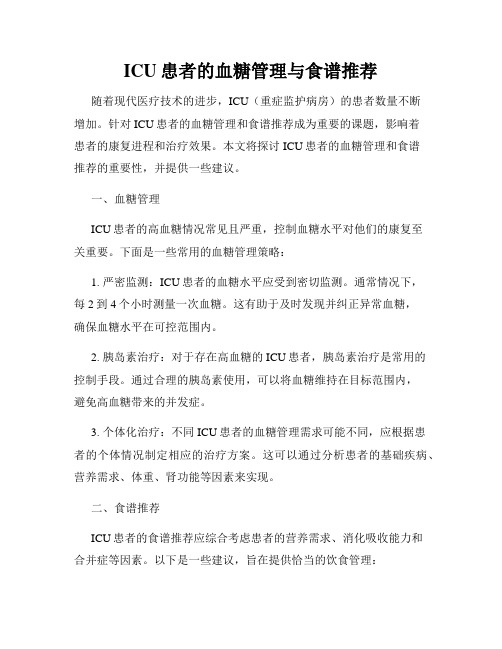
ICU患者的血糖管理与食谱推荐随着现代医疗技术的进步,ICU(重症监护病房)的患者数量不断增加。
针对ICU患者的血糖管理和食谱推荐成为重要的课题,影响着患者的康复进程和治疗效果。
本文将探讨ICU患者的血糖管理和食谱推荐的重要性,并提供一些建议。
一、血糖管理ICU患者的高血糖情况常见且严重,控制血糖水平对他们的康复至关重要。
下面是一些常用的血糖管理策略:1. 严密监测:ICU患者的血糖水平应受到密切监测。
通常情况下,每2到4个小时测量一次血糖。
这有助于及时发现并纠正异常血糖,确保血糖水平在可控范围内。
2. 胰岛素治疗:对于存在高血糖的ICU患者,胰岛素治疗是常用的控制手段。
通过合理的胰岛素使用,可以将血糖维持在目标范围内,避免高血糖带来的并发症。
3. 个体化治疗:不同ICU患者的血糖管理需求可能不同,应根据患者的个体情况制定相应的治疗方案。
这可以通过分析患者的基础疾病、营养需求、体重、肾功能等因素来实现。
二、食谱推荐ICU患者的食谱推荐应综合考虑患者的营养需求、消化吸收能力和合并症等因素。
以下是一些建议,旨在提供恰当的饮食管理:1. 高蛋白摄入:ICU患者的新陈代谢率较高,需要更多的蛋白质来维持肌肉和器官功能。
推荐患者摄入富含蛋白质的食物,如蛋、鱼、奶制品、豆类等。
2. 控制碳水化合物摄入:尽管碳水化合物是身体主要的能量来源,但对于ICU患者来说,过多的碳水化合物摄入可能导致高血糖。
因此,建议限制患者摄入过多的主食和糖类食物。
3. 维持液体平衡:ICU患者常存在液体丢失或潴留的情况。
在饮食管理中,需要根据患者的具体情况确定液体摄入量,确保水平衡和电解质稳定。
4. 考虑口服能力:由于ICU患者常常需要卧床休养或接受人工通气支持,他们的吞咽和咀嚼能力可能受到限制。
因此,在饮食推荐中,应考虑到患者的口服能力,提供易于吞咽和消化的食物。
5. 预防营养不足:由于疾病和治疗的压力,ICU患者容易出现营养不良。
ICU患者的血糖控制与监测
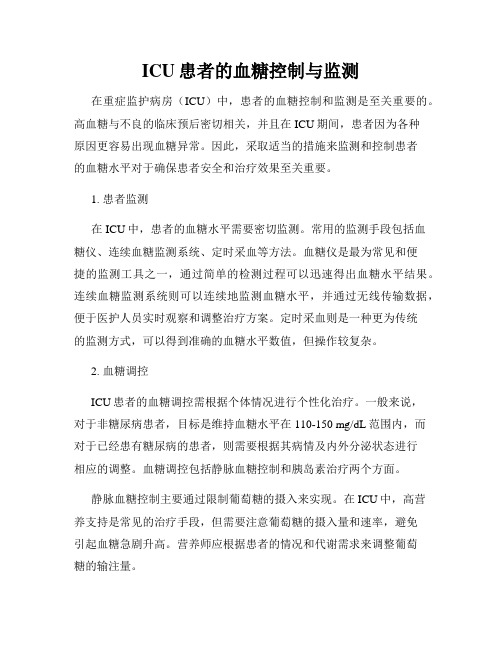
ICU患者的血糖控制与监测在重症监护病房(ICU)中,患者的血糖控制和监测是至关重要的。
高血糖与不良的临床预后密切相关,并且在ICU期间,患者因为各种原因更容易出现血糖异常。
因此,采取适当的措施来监测和控制患者的血糖水平对于确保患者安全和治疗效果至关重要。
1. 患者监测在ICU中,患者的血糖水平需要密切监测。
常用的监测手段包括血糖仪、连续血糖监测系统、定时采血等方法。
血糖仪是最为常见和便捷的监测工具之一,通过简单的检测过程可以迅速得出血糖水平结果。
连续血糖监测系统则可以连续地监测血糖水平,并通过无线传输数据,便于医护人员实时观察和调整治疗方案。
定时采血则是一种更为传统的监测方式,可以得到准确的血糖水平数值,但操作较复杂。
2. 血糖调控ICU患者的血糖调控需根据个体情况进行个性化治疗。
一般来说,对于非糖尿病患者,目标是维持血糖水平在110-150 mg/dL范围内,而对于已经患有糖尿病的患者,则需要根据其病情及内外分泌状态进行相应的调整。
血糖调控包括静脉血糖控制和胰岛素治疗两个方面。
静脉血糖控制主要通过限制葡萄糖的摄入来实现。
在ICU中,高营养支持是常见的治疗手段,但需要注意葡萄糖的摄入量和速率,避免引起血糖急剧升高。
营养师应根据患者的情况和代谢需求来调整葡萄糖的输注量。
胰岛素治疗是控制ICU患者血糖的关键手段之一。
胰岛素可以通过促使葡萄糖进入细胞,降低血糖水平。
根据患者情况,可选择连续静脉滴注或予以剂量化胰岛素注射。
剂量的选择应根据患者的血糖水平、营养状态和胰岛素敏感性等因素综合考虑。
3. 监测与干预除了常规监测和调控之外,ICU患者的血糖控制还需要加强监测和及时干预。
一旦发现血糖异常,应立即采取相应措施进行干预。
例如,如果发现血糖水平过高,即超过目标范围,可以适量增加胰岛素剂量。
相反,如果血糖水平过低,即低于目标范围,可减少或停止胰岛素的使用,并适量提供葡萄糖补充。
此外,ICU患者的营养状况也需要被重视。
ICU患者的血糖管理与调控

ICU患者的血糖管理与调控随着现代医学的进步,重症监护病房(ICU)在病人治疗和监护中起着至关重要的作用。
其中,ICU患者的血糖管理和调控是一个非常关键的方面。
本文将探讨ICU患者血糖管理的重要性,以及现有的血糖调控方法。
I. 血糖管理的重要性在ICU中,患者通常处于严重疾病状态,血糖水平的管理对患者的康复和治疗具有重要的影响。
以下是血糖管理的几个重要原因:1. 避免高血糖:ICU患者高血糖的风险较高,可能导致感染、肺炎等并发症的增加。
因此,维持适宜的血糖水平对于患者的恢复至关重要。
2. 防止低血糖:血糖过低可能导致患者出现头晕、嗜睡等症状,甚至危及生命。
通过合理的血糖管理,可以避免低血糖的发生。
II. 目前的血糖调控方法如何有效地管理ICU患者的血糖水平是一个具有挑战性的任务。
目前,常见的血糖调控方法如下:1. 定时监测:ICU患者的血糖水平需要定期监测,通常以每4-6小时为一次。
通过持续的监测,可以及时调整血糖管理策略。
2. 靶控血糖水平:目前,对于ICU患者的血糖管理,通常采用靶控血糖水平的策略。
根据患者的病情和个体差异,医生会制定一个适当的血糖范围,然后通过控制胰岛素的用量进行调控。
3. 胰岛素治疗:对于ICU患者的高血糖管理,胰岛素治疗是一种常见的方法。
胰岛素可以通过促进葡萄糖的吸收和利用来降低血糖水平。
4. 胰岛素泵:胰岛素泵是一种常见的血糖调控工具。
通过以恒定速率输注胰岛素,可以更好地控制患者的血糖水平。
5. 营养支持:恰当的营养支持也是ICU患者血糖调控的重要环节。
合理控制患者的饮食结构和摄入量,可以帮助稳定血糖水平。
III. 血糖管理的挑战和改进空间尽管有现有的血糖调控方法,ICU患者的血糖管理依然存在一些挑战:1. 患者个体差异:每个患者的代谢水平和胰岛素敏感性存在差异,因此,确定一个适合所有患者的统一血糖范围是具有挑战性的。
2. 监测频率:尽管血糖监测的频率已经提高,但在某些情况下,这仍然可能不足以满足患者血糖管理的需求。
ICU血糖监测及控制标准

ICU血糖监测及控制标准
目标:保持血糖水平于8~10mmol/L 。
血糖>10mmol/L或<5mmol/L时应通知医生
静脉应用胰岛素剂量调整:
注意事项:
1、使用胰岛素必须遵医嘱按时监测血糖。
2、初始静脉应用胰岛素及较大幅度调整胰岛素剂量后1小时应加测血糖。
3、疑有低血糖时应立即加测血糖,并报告医生,及时处理。
4、使用或停止肠内、肠外营养时,需根据医嘱及时调整胰岛素泵入速度。
5、对于休克、应用升压药、严重外周组织水肿和长期静脉输注胰岛素的患者,选用动脉或静脉的全血标本,而不是指尖毛细血管的标本检测血糖。
ICU护理中的血糖控制和糖病管理
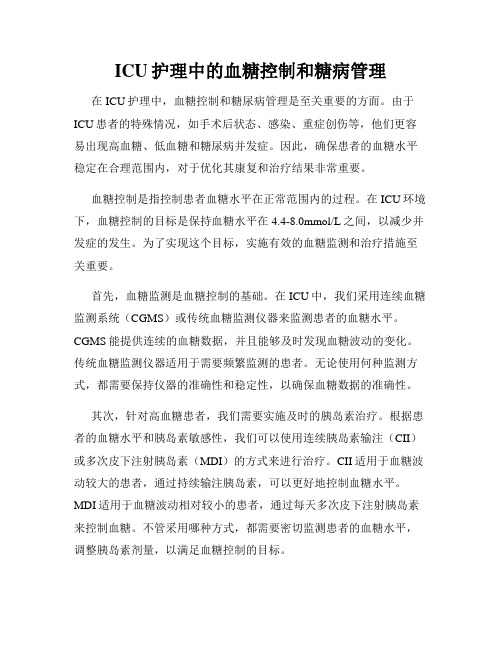
ICU护理中的血糖控制和糖病管理在ICU护理中,血糖控制和糖尿病管理是至关重要的方面。
由于ICU患者的特殊情况,如手术后状态、感染、重症创伤等,他们更容易出现高血糖、低血糖和糖尿病并发症。
因此,确保患者的血糖水平稳定在合理范围内,对于优化其康复和治疗结果非常重要。
血糖控制是指控制患者血糖水平在正常范围内的过程。
在ICU环境下,血糖控制的目标是保持血糖水平在4.4-8.0mmol/L之间,以减少并发症的发生。
为了实现这个目标,实施有效的血糖监测和治疗措施至关重要。
首先,血糖监测是血糖控制的基础。
在ICU中,我们采用连续血糖监测系统(CGMS)或传统血糖监测仪器来监测患者的血糖水平。
CGMS能提供连续的血糖数据,并且能够及时发现血糖波动的变化。
传统血糖监测仪器适用于需要频繁监测的患者。
无论使用何种监测方式,都需要保持仪器的准确性和稳定性,以确保血糖数据的准确性。
其次,针对高血糖患者,我们需要实施及时的胰岛素治疗。
根据患者的血糖水平和胰岛素敏感性,我们可以使用连续胰岛素输注(CII)或多次皮下注射胰岛素(MDI)的方式来进行治疗。
CII适用于血糖波动较大的患者,通过持续输注胰岛素,可以更好地控制血糖水平。
MDI适用于血糖波动相对较小的患者,通过每天多次皮下注射胰岛素来控制血糖。
不管采用哪种方式,都需要密切监测患者的血糖水平,调整胰岛素剂量,以满足血糖控制的目标。
另外,低血糖也是ICU患者面临的风险之一。
低血糖可能导致意识状态改变、神经系统损伤等严重后果。
为避免低血糖的发生,我们需要避免快速过渡的血糖控制方法,如严格控制胰岛素剂量和输注速率。
此外,我们还需要监测患者的饮食摄入情况,并根据患者的需要进行适当的血糖调整。
对于无法经口进食的患者,我们需要通过静脉途径提供适当的营养支持,以满足患者的能量需求和血糖控制的需要。
除了血糖控制之外,糖尿病管理也是ICU护理中的重要环节。
对于已知糖尿病患者和糖尿病风险患者,我们需要在ICU期间继续管理其糖尿病。
ICU患者血糖监测

02
血糖监测可以及时发现低
血糖和高血糖,避免因血
糖异常导致的并发症。
03
血糖监测可以帮助医生调 整治疗方案,提高治疗效 果。
04
血糖监测可以预测患者的
预后,为医生提供决策支
持。
血糖监测在ICU患者护理中的应用
1
监测血糖水平:实 时监测ICU患者血 糖水平,及时发现
异常情况
2
调整治疗方案:根 据血糖监测结果, 调整治疗方案,提
02
血糖波动可能 导致患者出现 昏迷、抽搐等 症状,影响患 者的生活质量。
03
血糖波动可能导 致患者出现感染、 败血症等并发者出现心脑 血管疾病、肾功 能衰竭等严重并 发症,影响患者 的生命安全。
血糖监测对ICU患者的意义
01
及时发现血糖异 常:ICU患者血 糖波动较大,及 时监测有助于及 时发现异常情况, 及时采取措施。
ICU患者血糖监 测
目录
01. ICU患者血糖监测的重要性 02. ICU患者血糖监测的方法 03. ICU患者血糖监测的注意事
项
04. ICU患者血糖监测的临床应 用
1
ICU患者血糖监 测的重要性
血糖波动对ICU患者的影响
01
血糖波动可能 导致患者出现 低血糖或高血 糖,影响患者 的生命安全。
3
智能血糖监测 设备:结合智 能手机和血糖 仪,实现远程 监测和预警
4
生物传感器技 术:通过检测 汗液、眼泪等 体液中的葡萄 糖含量,实现 无创血糖监测
3
ICU患者血糖监 测的注意事项
监测频率
01
初始阶段:每1-2小时监 测一次
03
特殊患者:根据病情调 整监测频率
ICU患者的血糖管理与监测
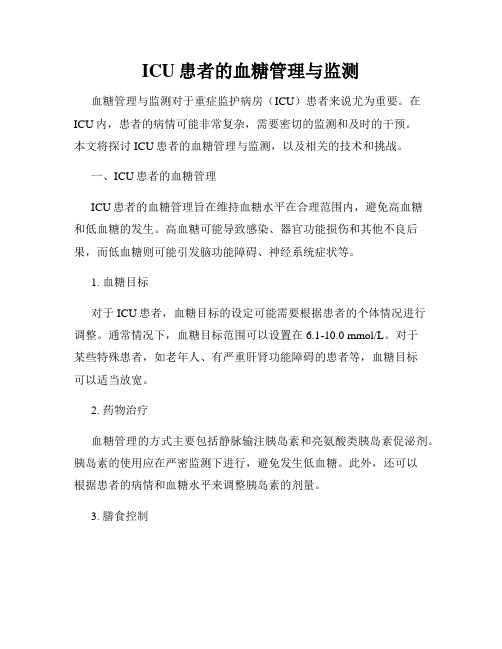
ICU患者的血糖管理与监测血糖管理与监测对于重症监护病房(ICU)患者来说尤为重要。
在ICU内,患者的病情可能非常复杂,需要密切的监测和及时的干预。
本文将探讨ICU患者的血糖管理与监测,以及相关的技术和挑战。
一、ICU患者的血糖管理ICU患者的血糖管理旨在维持血糖水平在合理范围内,避免高血糖和低血糖的发生。
高血糖可能导致感染、器官功能损伤和其他不良后果,而低血糖则可能引发脑功能障碍、神经系统症状等。
1. 血糖目标对于ICU患者,血糖目标的设定可能需要根据患者的个体情况进行调整。
通常情况下,血糖目标范围可以设置在6.1-10.0 mmol/L。
对于某些特殊患者,如老年人、有严重肝肾功能障碍的患者等,血糖目标可以适当放宽。
2. 药物治疗血糖管理的方式主要包括静脉输注胰岛素和亮氨酸类胰岛素促泌剂。
胰岛素的使用应在严密监测下进行,避免发生低血糖。
此外,还可以根据患者的病情和血糖水平来调整胰岛素的剂量。
3. 膳食控制ICU患者的膳食控制应以个体化为基础,根据患者的能量需求和血糖控制的目标来调整。
通常情况下,应提供适量、均衡的营养,并根据需要补充蛋白质等营养物质。
二、ICU患者的血糖监测血糖监测是血糖管理的基础,可以帮助医护人员了解患者的血糖水平,及时调整治疗方案。
1. 血糖监测技术血糖监测的常用技术包括血糖仪、连续血糖监测系统(CGM)和动态血糖监测系统(DGM)。
血糖仪通过采集患者的血液样本,测定血糖水平。
CGM可以连续监测患者的血糖水平,并提供实时数据和波形图,帮助医护人员更好地了解患者的血糖变化趋势。
DGM结合了连续血糖监测和胰岛素泵,可以进行动态血糖监测和治疗。
2. 血糖监测频率ICU患者的血糖监测应该是持续的,且频率可能需要根据患者情况进行调整。
通常情况下,可以每2-4小时进行一次血糖监测。
对于血糖控制较为稳定的患者,监测频率可以适度减少。
三、ICU患者血糖管理的挑战ICU患者的血糖管理面临一些特殊的挑战,需要医护人员密切关注和及时干预。
ICU患者床边血糖监测
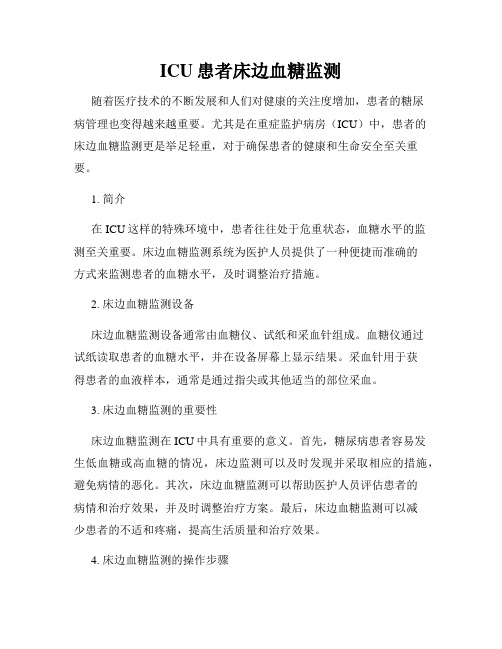
ICU患者床边血糖监测随着医疗技术的不断发展和人们对健康的关注度增加,患者的糖尿病管理也变得越来越重要。
尤其是在重症监护病房(ICU)中,患者的床边血糖监测更是举足轻重,对于确保患者的健康和生命安全至关重要。
1. 简介在ICU这样的特殊环境中,患者往往处于危重状态,血糖水平的监测至关重要。
床边血糖监测系统为医护人员提供了一种便捷而准确的方式来监测患者的血糖水平,及时调整治疗措施。
2. 床边血糖监测设备床边血糖监测设备通常由血糖仪、试纸和采血针组成。
血糖仪通过试纸读取患者的血糖水平,并在设备屏幕上显示结果。
采血针用于获得患者的血液样本,通常是通过指尖或其他适当的部位采血。
3. 床边血糖监测的重要性床边血糖监测在ICU中具有重要的意义。
首先,糖尿病患者容易发生低血糖或高血糖的情况,床边监测可以及时发现并采取相应的措施,避免病情的恶化。
其次,床边血糖监测可以帮助医护人员评估患者的病情和治疗效果,并及时调整治疗方案。
最后,床边血糖监测可以减少患者的不适和疼痛,提高生活质量和治疗效果。
4. 床边血糖监测的操作步骤床边血糖监测的操作相对简单,但需要严格遵循一定的步骤。
首先,医护人员需要准备好所需的设备,包括血糖仪、试纸和采血针等。
接下来,选择适当的采血部位并进行消毒,然后使用采血针采集血液样本。
将血液样本滴在试纸上,并将试纸插入血糖仪中进行读数。
最后,根据读数结果,医护人员可以及时采取相应的治疗措施。
5. 床边血糖监测的注意事项在进行床边血糖监测时,医护人员需要注意一些事项。
首先,保持设备的清洁和消毒,以确保结果的准确性。
其次,按照设备的说明书和操作规范进行操作,避免误差的发生。
另外,还需要留意患者的病情变化和治疗效果,并及时调整监测频率和治疗方案。
6. 床边血糖监测的挑战与解决方案床边血糖监测在实际操作中可能面临一些挑战,例如患者的血糖波动、采血困难等。
针对这些问题,医护人员可以通过合理的治疗方案和技巧来解决,例如增加血糖监测频率、选择适当的采血部位等。
ICU患者的血糖管理与控制

ICU患者的血糖管理与控制血糖管理对于住院中的重症监护患者尤为重要。
ICU患者的血糖管理与控制涉及到合理的血糖监测、适当的胰岛素治疗以及临床团队的合作与协调等方面。
本文将介绍ICU患者血糖管理的重要性,探讨血糖控制的目标,以及有效的血糖管理策略。
一、ICU患者血糖管理的重要性重症监护患者往往在ICU内经历严重的生理应激状态,其机体代谢紊乱严重,血糖波动较大。
高血糖水平与不良预后之间存在密切的关联。
研究表明,高血糖和高血糖变异性都与ICU患者的住院时间、并发症发生率和病死率增加有关。
因此,血糖管理对于ICU患者的康复具有重要的意义。
二、血糖控制的目标在ICU患者血糖控制过程中,需要确定适当的目标范围。
目前,国际上普遍接受的血糖控制目标是4.4~6.1 mmol/L(80~110 mg/dL)。
然而,对于某些特殊病例,如老年患者或严重疾病伴发糖尿病患者,目标范围可能需要略微调整以避免低血糖风险。
三、有效的血糖管理策略1. 血糖监测:对于ICU患者,血糖监测应该是连续的、准确的和及时的。
传统的指尖采血测试是最常见的监测方法,但它可能无法满足ICU患者的特殊需求。
近年来,连续血糖监测技术的发展为ICU患者提供了更为精确和方便的血糖监测方式。
2. 胰岛素治疗:对于ICU患者,胰岛素治疗是控制血糖的主要手段之一。
根据患者的血糖水平和胰岛素敏感性,可以选择不同的胰岛素治疗方案,如基础胰岛素和靶控胰岛素。
但需要注意的是,严密的监测和调整胰岛素剂量以避免低血糖的发生。
3. 协同管理:ICU患者的血糖管理需要临床团队的协同配合。
包括医生、护士、病理师和营养师等专业人员在内的多学科合作是确保血糖管理效果的关键。
团队成员需要相互沟通,并制定血糖管理的具体方案和策略。
4. 营养支持:合理的营养支持也是ICU患者血糖管理的重要组成部分。
需要根据患者的营养状况和血糖水平,制定适当的营养计划。
同时,临床团队还需要密切监测患者的胰岛素需求,及时调整营养支持方案。
重症加强治疗病房icu患者血糖的管理

重症加强治疗病房ICU患者血糖的管理xx年xx月xx日CATALOGUE 目录•引言•ICU患者血糖管理现状•ICU患者血糖管理对策•ICU患者血糖控制效果评价•案例分析•总结与建议01引言ICU患者病情危重,常合并应激性高血糖高血糖可增加不良事件发生风险,影响预后强化血糖管理可改善患者预后背景介绍研究目的和意义研究ICU患者血糖管理策略分析不同血糖控制目标对预后的影响为临床制定血糖管理方案提供参考文献综述国际指南推荐强化血糖管理策略研究显示ICU患者高血糖与不良预后相关需要进一步探讨最佳血糖控制策略但不同指南对于血糖控制目标存在差异02ICU患者血糖管理现状1ICU患者血糖管理的重要性23ICU患者往往伴有应激性高血糖,血糖控制不佳会加重病情,影响预后。
重症患者的常见并发症高血糖可导致机体免疫力下降、代谢紊乱、器官功能障碍等。
高血糖对机体功能的影响高血糖可导致机械通气时间和住院时间延长,增加医疗费用和死亡率。
影响机械通气时间和住院时间我国ICU患者血糖管理的现状缺乏规范化管理流程目前我国ICU患者血糖管理尚未形成规范化流程,各医院和科室管理水平和标准不一。
检测手段和方法不统一血糖检测方法和仪器不统一,导致数据不规范、不准确。
护士和医生缺乏培训护士和医生缺乏对高血糖危害和管理的认识和培训。
03缺乏标准化评估指标ICU患者血糖管理的评估指标缺乏标准化,难以进行横向比较和评估。
ICU患者血糖管理的问题01缺乏多学科协作ICU患者血糖管理需要多学科协作,包括内分泌科、急诊科、重症医学科等。
02监测与控制不连续ICU患者血糖监测和控制不连续,缺乏动态监测和精细管理。
03ICU患者血糖管理对策1制定合理的血糖控制方案23根据患者病情和血糖水平,制定个体化的血糖控制目标。
选择适合的胰岛素治疗方案,包括胰岛素类型、给药途径和剂量调整等。
充分考虑患者的营养需求和饮食影响,制定合理的营养支持计划。
医护人员培训及血糖监测01对医护人员进行定期培训,提高对高血糖危害的认识和血糖管理技能。
- 1、下载文档前请自行甄别文档内容的完整性,平台不提供额外的编辑、内容补充、找答案等附加服务。
- 2、"仅部分预览"的文档,不可在线预览部分如存在完整性等问题,可反馈申请退款(可完整预览的文档不适用该条件!)。
- 3、如文档侵犯您的权益,请联系客服反馈,我们会尽快为您处理(人工客服工作时间:9:00-18:30)。
h
21
2008---Surviving Sepsis Campaign: International guidelines for management of severe sepsis and septic shock
随机分为:
传统治疗组
强化胰岛素治疗组
血糖高于215mg/dL(12
传统治疗组
mmol/L)输注胰岛素
维持在180—
200mg/dL(10—
Intensive insulin therapy in the1c1rmiticmalloyli/llLp)atients
(危重患者的强化胰岛素治疗)
反向调节激素产生增加
诱发炎症反应的细胞因子产生 增多,诱发胰岛素抵抗 外源性因素的作用进一步促使高 血糖的发生(激素,含糖液体)
高血糖
h
7
危重症患者血糖的变化 危重症患者高血糖的危害 最佳的血糖控制水平 护理 小结
h
8
高血糖增加患者的感染机会
高血糖组
感染率 未感染
正常血糖组
感染率 未感染
74例烧伤无糖尿病患者
我们建议,所有接受静脉注射胰岛素患者应接受 葡萄糖为热量来源,并且每1-2小时监测血糖值, 直到血糖水平和胰岛素输注率稳定后每4小时监测 血糖值(Grade 1C)
h
23
2008---Surviving Sepsis Campaign: International guidelines for management of severe sepsis and septic shock
3.89—6.11
降糖激素
胰岛素(体内唯一降低血糖 的激素)
h
4
血糖水平异常
糖代谢障碍→血糖水平紊乱 一 高血糖
糖尿病:type1,type 2,特异型糖尿病, 妊娠糖尿病
应激状态下的高血糖状态 二 低血糖
h
5
危重症患者高血糖的原因
高龄
应激状态
肥胖症
糖的摄入 糖尿病
h
6
应激状态下发生高血糖的原因
L to R: Investigator Dr. Vinay Dhingra discusses the SUGAR study with research co-
ordinators Susan Logie and Laurie Smith along with Canadian project managher
NICE SUGAR研究
Surviving Sepsis Campaign
强化血糖控制
2009年 2008年 2001年
h
15
血糖控制--强化胰岛素治疗
前瞻性随机对照试验
强化胰岛素治疗组
外科ICU机械通气成人患者 1548例
维持血糖80—110 mg/dL (4.4—6.1 mmol/L)
4. We recommend that low glucose levels obtained with point-of-care testing of capillary blood be interpreted with caution, as such measurements may overestimate arterial blood or plasma glucose values (Grade 1B)
无论有无糖尿病病史,应用胰岛素将血糖水平控 制在110 mg/dL(6.1 mmol/L)以下能降低外 科ICU患者死亡率。
h
19
Van den Berghe G, et al: Intensive insulin therapy in the critically ill patients. N Engl J Med 2001; 345: 1359–1367.
3.We recommend that all patients receiving intravenous insulin receive a glucose calorie source and that blood glucose values be monitored every 1–2 hours until glucose values and insulin infusion rates are stable and then every 4 hours thereafter (Grade 1C)
2.We suggest use of a validated protocol for insulin dose adjustments and targeting glucose levels to the < 150 mg/dl range (8.3mmol/L) (Grade 2C)
我们建议使用有效的方案来调整胰岛素剂量,
Involving 42 hospitals from four countries and two continents
Of the 6104 patients who underwent randomization, 3054 were assigned to undergo intensive control and 3050 to undergo
超过90 %的危重病人会发生高血糖,并且 会增加几乎所有亚组ICU患者的发病率和死 亡率
h
12
危重症患者血糖的变化 危重症患者高血糖的危害 最佳的血糖控制水平 护理 小结
h
13
最佳目标血糖水平?
是否血糖水平在正常范围内就能降低死亡率? 什么样的血糖水平可使ICU患者获益最大?
h
14
危重病人血糖控制史上的“里程碑”
25
Denise Foster.
NICE SUGAR研究 :Background 背景
A parallel-group, randomized, controlled trial involving adult medical and surgical patients admitted to the ICUs of 42 hospitals: 38 academic tertiary care hospitals and 4 community hospitals
ICU患者血糖的监测与管 理
h
1
内容提要
危重症患者血糖的变化 危重症患者高血糖的危害 最佳的血糖控制水平 护理 小结
h
2
危重症患者血糖的变化 危重症患者高血糖的危害 最佳的血糖控制水平 护理 小结
h
3
血糖水平的调节
升糖激素
胰高血糖素、肾上腺皮质激 素、肾上腺髓质激素、生长 激素、甲状腺素、性激素、 HCG
ห้องสมุดไป่ตู้
血糖控制 --强化胰岛素治疗
In conclusion, the use of exogenous insulin to maintain blood glucose at a level no higher than 110 mg per deciliter reduced morbidity and mortality among critically ill patients in the surgical intensive care unit, regardless of whether they had a history of diabetes
11
ICU患者高血糖的危害
Hyperglycemia occurs in up to 90 % of critically ill patients and is associated with increased morbidity and mortality in virtually all subgroups of intensive care unit (ICU) patients.
1.We recommend that, following initial stabilization, patients with severe sepsis and hyperglycemia who are admitted to the ICU receive IV insulin therapy to reduce blood glucose levels (Grade 1B)
由手指血糖测得的低血糖水平应持谨慎态度, 因为这种测量获得的数值可能高于动脉血或血 清值(Grade 1B)
h
24
Can controlling blood sugar levels in the
ICU save your life? 控制血糖水平能拯救ICU患者的生命吗?
Tue Mar 24, 2009 Landmark studies published in New England
强化胰岛素治疗-低血糖
强化胰岛素治疗可使低血糖发生率增加60% ( 低血糖定义为2.2mmol /L)
多发生在禁食、病情极危重或胰岛素过量时 (特别是危重患者多有意识障碍或接受机械通气、镇静 类药物等从而使低血糖的症状、体征不典型) 可导致神经系统不可逆性损害,严重的脑损害,甚至死 亡。
h
20
2008---Surviving Sepsis Campaign: International guidelines for management of severe sepsis and septic shock
Van den Berghe G, et al.N Engl J Med 2001; 345: 1359–1367.
h
16
.
血糖控制--强化胰岛素治疗
平均跟踪23天结局
